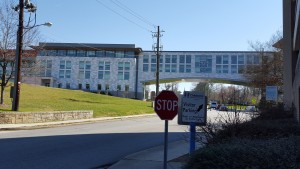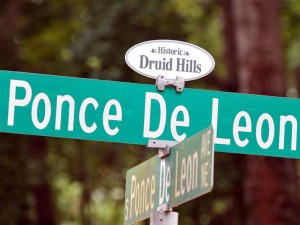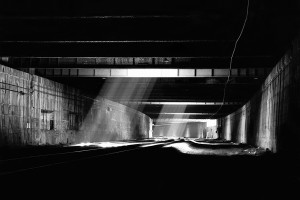This artifact known as the Fernbank Museum of Natural History opened in 1992 that covers more than 160,000 square feet of the historic Fernbank Forest in Atlanta. This museum focuses on promoting lifelong learning and encouraging a greater appreciation of the earth and its people. The Fernbank Museum includes various exhibitions, tours, and IMAX film screenings. The dinosaurs that are in front of the building are what caught my eye and made me want to learn more about this artifact.
Exterior: Druid Hills #3
This artifact known as Druid Hills High School is one of the oldest schools in DeKalb County. This school originated from Emory University in the Fishburne Building in 1919 as a school for faculty children. Two things in particular that caught my attention about this school was their cafeteria and the fact that they’re an International Baccalaureate Programme. The cafeteria architect and modern design set it apart from the rest of this plain and boring looking school. While the fact that it is an International Baccalaureate Programme stood out the most, especially since the police happened to pull up on campus to drop three out of ten students who were caught leaving campus while I was taking pictures back off.
Exterior: Druid Hills #2

Korschun, Holly. “New Health Sciences Research Building Ready for Move-in | Emory University | Atlanta, GA.” Emory News Center | Emory University | Atlanta, GA. Emory University, 21 June 2013. Web. 12 Feb. 2016.
This artifact known as the Emory Brumley Bridge that is named in honor of George Brumley, who was chair of Emory Department of Pediatrics from 1981 to 1995. Brumley was killed in a plane crash in 2003. According to Emory news center, this bridge connects the third and fourth floors of the Health Sciences Research Building (HSRB) to the fourth and fifth floors of the Emory – Children Center building.
Exterior: Druid Hills #1
This sound describes how busy this active neighborhood is with constant traffic flowing throughout this community. The only streets that are not as busy as the main roads are the ones where residents reside. The Druid Hills community is an exquisite community to live in if you don’t mind a tremendous flow of traffic and streets that don’t have a residential parking in almost every area.
Bibliographic Annotations
“College Residence and Academic Performance: Who Benefits From Living on Campus?” College Residence and Academic Performance: Who Benefits From Living on Campus? Web. 05 Feb. 2016. >.
In this article Professors, Ruth N. López Turley and Geoffrey Wodtke discuss the effects of living on campus for college freshman and how it promotes a variety of desirable outcomes for the students’. The view that these two professors have on this particular research is unbiased and provides various details on how someone’s GPA and the change they experience living on campus versus those who live off campus with family. What’s intriguing about this article is that it explores the different factors you take into account when comparing the benefits of one over the other such as what type of college it is, the various types of students that attend the college, and the ethnic background of the larger population. This article ties into how the built environment impacts the lives of the people who inhabit within it. The source of this article does not take a good stand on the following subject but provides great information on the studies that were taken.
Watson, Jaye. “Metro Atlanta Mom Writes Why White Parents Won’t Choose Black Schools.”11Alive. N.p., 10 Oct. 2015. Web. 05 Feb. 2016.
In the story aired by 11Alive last year, this woman named Abby Norman who is the mother of two kids, and an English teacher who lives in an Atlanta area with white residents posted a blog about racism and education. Mrs. Norman, who sends her kindergartner to the neighborhood school, was told by many of her white neighbors not to send her children there. In the post she wrote on her blog, she says “This summer, when I told the other moms at the pool where my kids went to school. I was repeatedly told to move them. This from women who had never set foot in my school. They had not had contact with our deeply passionate, and very responsive principal, had not met the pre-k teachers who my daughter loves more than Santa.” Although Mrs. Norman would voice her opinion to these other moms, the criticism was still there. This article does an excellent job of showing how race means nothing, as long as your child is receiving a great education and meets friendly people that will show her the right direction, the color of your will never matter because we are all equal.
Oakley, Deirdre. Ruel, Erin. Reid, Lesley. “Atlanta’s Last Demolitions and Relocations: The Relationship Between Neighborhood Characteristics and Resident Satisfaction.” Housing Studies. 28.2(2013): 205. Advanced Placement Source. Web. 5 Feb, 2016.
In this article written by three Sociology professors, they discuss how moving lower income communities to better neighborhoods will increase their happiness, ability to make money and have a stable job, and their helpfulness to society. The people who were relocated were moved to safer areas, which allowed them to live happier and longer lives. This move caused a tremendous drop in the crime rate for that particular area and the whole city as well. The authors wrote this journal to inform people on how changes to an environment can change the person and their whole attitude and demeanor. This article gave me more insight on how I want to help stop crime in the low-income areas around and outside of Atlanta.
Druid Hills

Leslie, Katie, and Mark Niesse. Residents in the Druid Hills neighborhood, one of the oldest and wealthiest communities in the Atlanta area, will soon consider a key question about their future: Should they stay or go?. Photograph. http://www.myajc.com/news/news/local-govt-politics/druid-hills-considers-becoming-part-of-atlanta/ngrzT/. The Atlanta Journal-Constitution, 31 July 2014. Web. 1 Feb. 2016.
This is a picture of one of the oldest and wealthiest communities in Atlanta, Georgia.
Built Environment Descriptions
Will we ever get to choose an environment that we find interesting to ourselves without selecting one from the list of the places that you and Mrs.A provide in this course?
Extra Credit Opportunity
I attended the two-thousand and fourteen Belk Bowl game of The University of Georgia Bulldogs against The Louisville Cardinals.
#GoDawgs !
TAPESTRY OF SPACE: DOMESTIC ARCHITECTURE AND UNDERGROUND COMMUNITIES IN MARGARET MORTON’S PHOTOGRAPHY OF A FORGOTTEN NEW YORK
ARCHITECTURAL EXCLUSION: DISCRIMINATION AND SEGREGATION THROUGH PHYSICAL DESIGN OF THE BUILT ENVIRONMENT
In this article named Architectural Exclusion: Discrimination And Segregation Through Physical Design Of The Built Environment by Sarah Schindler she discusses how infrastructures such as public transit systems and highways are being used to keep certain segments of the population the – often the poor and the people of color – separate from the others, particularly the wealthy whites and suburban communities. This article stresses how the lawmakers, courts, judges, legislators, and elected officials treat the architectural exclusion. Throughout this article Schindler examines how the built environment controls and regulates our behavior and how architectural exclusion manipulates their residents, local elected officials, and police forces through their actions of creating and designing infrastructures and built environs to restrict passage through and access to certain areas of communities.
The first section of this article speaks briefly of how most citizens are blind to how architecture is coined as regulation through the systemic social inequality that is apart of these monumental structures of concrete and steel. A quotation that will help you understand and summarizes this first section well, is Nicholas Blomley’s term “traffic logic”: “the idea that planners and civil engineers prioritize the flow of pedestrians and traffic through a physical space, with a focus on civil engineering, rather than prioritizing equal access to a physical space for all, with a focus on civil rights” (Schindler, 1945). Blomley’s quotation summarizes how many cities facilitate planning decisions that include exclusions and how various legal scholars have confronted these concepts in context to class and race.
The second section discusses how various states and municipalities create and design different infrastructures to exclude localities from having access to physical barriers, such as buildings walls and barriers so the poor and African-Americans cannot have access to them. Some other things that revolve around architectural exclusions are transit systems that include these exclusionary transportation designs: placement of transit stops, highway routes, bridge exits, and road infrastructure, wayfinding: one-way streets, dead- end streets, and confusing signage, and residential parking permits. Throughout all of these sections, they explain how race has been a contributing factor for limiting the geography of transit to eliminate low-income and minority neighborhoods. A great example that describes this from the text would be the scenario about Cynthia Wiggins, “a seventeen-year-old woman who was hit and killed by a dump truck while she was attempting to cross a seven lane highway to get to the mall where she worked” (Schindler, 1964). Another example that shows that these white residents are still succeeding in keeping black residents out of their neighborhoods is the wealthy, mostly white residents of the northern Atlanta suburbs who have opposed efforts of MARTA expanding into their neighborhoods because they don’t want people of color to have way access to suburban communities. Also, the lack of public transit in these communities make it difficult for those who rely on transit to access job opportunities located in those suburbs
This article sums up the perfect example of architectural exclusion of malls, businesses, and residential areas using the highways, roads, and bridges as a way to exclude some city residents from those areas.


